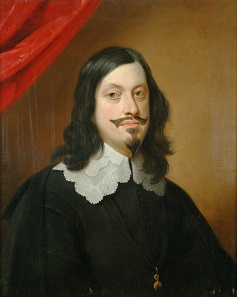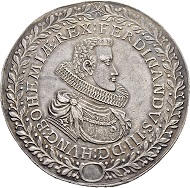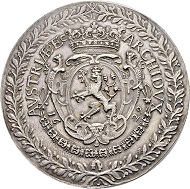by Lutz Neumann-Lysloff
In eastern central Europe we find large gold and silver coins minted in the 17th century that were definitely representational or donational in character. In the Habsburg Empire, Poland, Transylvania and Salzburg such pieces were minted in the weight of 100, 50, 40 and 20 ducats.
These coins were never meant for circulation. For such a purpose these coins were not suitable. At the best they might have been suited for land purchases, payments to army commanders, state debts, etc. But they were not meant for this purpose either.
They expressed the wealth and the “largesse” (generosity) of the depicted ruler on the coin, who gave them to merited subjects, foreign representatives or successful commanders.
Jan van den Hoecke, Portrait of Ferdinand III, 1643.
In the year 1629, Ferdinand III issued a series of startling coins, probably minted in Prague. Ferdinand III was the son of Emperor Ferdinand II and had been King of Hungary since 1625, King of Bohemia since 1627, he followed his father on the imperial throne after his death in 1637.
These stupendous coins were minted as 100 ducats, 50 ducats and 40 ducats, dated 1629 – and additionally in diverse taler weights. The dies were cut by Donat Stark from the Prague mint.
3 1/2 taler 1629 (on the coronation of Ferdinand III). Prague Mint.
The obverse shows the bust of Ferdinand to r. in Spanish court dress with a large ruff collar. He is surrounded by the titles of King of Hungary and Bohemia. Around the edge runs a laurel wreath. An empty oval enclosure below was meant to contain the punched denomination – 100, 50 or 40 ducats. Within the laurel wreath on the left and right are the letters D–S (for Donat Stark), extremely small. It is difficult to spot them. The reverse shows the Bohemian lion in a decorated frame beneath a royal crown. Below, you will find the collar of the Order of the Golden Fleece. Above to the sides, we read the title of Archduke of Austria. Here also a laurel wreath surrounds text and image, and here too, hardly legible, we read the signature of the die cutter D–S.
In general it is assumed that these coins were issued in occasion of the coronation of Ferdinand III as King of Bohemia. However, this poses a certain problem. Ferdinand III was crowned King of Bohemia in 1627, and these coins are dated 1629. They are, however, clearly of Bohemian origin as the large Bohemian lion arms reveal. The initials of Donat Stark refer clearly to the Prague mint. Strangely though, these appear not on the silver coinage.
A 3½ taler piece (a silver strike of the 100 ducats) will be auctioned in the forthcoming SINCONA AG auction 34. The coin (lot 4207) is estimated at CHF 20,000. It is an extremely rare denomination of a very rare series of coins and in wonderful quality.
This catalogue contains 200 talers, 9 multiple talers, many half-, and quarter talers, and numerous lots of small denominations. They stem mainly from the mints of Prague, Kuttenberg and Joachimsthal.
You can read an auction preview in CoinsWeekly.
If you want to browse through the auction catalogue click here.






